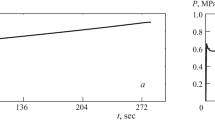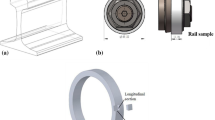Abstract
A surface worn C-Mn rail is repaired by retrieving the lost part of the railhead using a commercial rutile flux-cored wire submerged arc welding (SAW) method. Optical microscopy (OM), scanning electron microscopy (SEM), electron-dispersive X-ray spectroscopy (EDS), and Rockwell B hardness test are employed to investigate the properties of the repaired rail specimen. After the first set of analysis, the as-repaired rail is heated up to 1100 °C and water-quenched to room temperature to increase hardness. Each specimen is analytically partitioned into three zones including weld zone (WZ), heat-affected zone (HAZ), and the unaffected rail substrate. The as-repaired rail WZ is primarily composed of pearlite, ferrite, and austenite with a low hardness of 80 HRB, whereas the austenite phase is gone in the as-quenched rail and a massive extent of carbides are precipitated which increased hardness to 95 HRB. The microstructure of the HAZ in the as-repaired sample is a uniform distribution of fine-grained ferrite, pearlite, and carbide with the hardness of 92 HRB, while the microstructure of the identical zone in the as-quenched specimen is mainly martensitic-pearlitic with the highest average hardness among all zones, 110 HRB. The results presented an immense potential for SAW in rail repair.









Similar content being viewed by others
References
Cannon DF, Edel KO, Grassie SL, Sawley K (2003) Rail defects: an overview. Fatigue Fract Eng Mater Struct 26(10):865–886. https://doi.org/10.1046/j.1460-2695.2003.00693.x
Girsch G, Jorg A, Schoech W (2010) Managing rail life to match performance and cut costs. Railw Gaz Int 166(8):45–48
Kral RF, Mayhill SA, Johnson MQ, Rovnyak ME, Coomer DJ (2004) Method of repairing a rail. US Patent, US7520415B2 2004, issued April 21, 2009
Mortazavian E, Wang Z, Teng H (2018) Thermal-mechanical study of 3D printing technology for rail repair. Volume 2: Advanced Manufacturing, ASME, p. V002T02A052. https://doi.org/10.1115/IMECE2018-86315
Mortazavian E, Wang Z, Teng H (2019) Thermal-kinetic-mechanical modeling of laser powder deposition process for rail repair. Volume 2: Advanced Manufacturing, ASME
Yu T, Deng QL, Zheng JF, Dong G, Yang JG (2012) Microstructure and wear behaviour of laser clad NiCrBSi+Ta composite coating. Surf Eng 28(5):357–363. https://doi.org/10.1179/1743294411Y.0000000094
Lai Q, Abrahams R, Yan W, Qiu C, Mutton P, Paradowska A, Soodi M (2017) Investigation of a novel functionally graded material for the repair of premium hypereutectoid rails using laser cladding technology. Compos Part B Eng 130:174–191. https://doi.org/10.1016/J.COMPOSITESB.2017.07.089
Lai Q, Abrahams R, Yan W, Qiu C, Mutton P, Paradowska A, Fang X, Soodi M, Wu X (2018) Effects of preheating and carbon dilution on material characteristics of laser-cladded hypereutectoid rail steels. Mater Sci Eng A 712:548–563. https://doi.org/10.1016/J.MSEA.2017.12.003
Roy T, Lai Q, Abrahams R, Mutton P, Paradowska A, Soodi M, Yan W (2018) Effect of deposition material and heat treatment on wear and rolling contact fatigue of laser cladded rails. Wear 412–413:69–81. https://doi.org/10.1016/J.WEAR.2018.07.001
Lai Q, Abrahams R, Yan W, Qiu C, Mutton P, Paradowska A, Soodi M, Wu X (2019) Influences of depositing materials, processing parameters and heating conditions on material characteristics of laser-cladded hypereutectoid rails. J Mater Process Technol 263:1–20. https://doi.org/10.1016/J.JMATPROTEC.2018.07.035
Clare AT, Oyelola O, Folkes J, Farayibi PK (2012) Laser cladding for railway repair and preventative maintenance. J Laser Appl 24(3):032004. https://doi.org/10.2351/1.4710578
Clare AT, Oyelola O, Abioye TE, Farayibi PK (2013) Laser cladding of rail steel with Co–Cr. Surf Eng 29(10):731–736. https://doi.org/10.1179/1743294412Y.0000000075
Hiensch EJM, Franklin FJ, Nielsen JCO, Ringsberg JW, Weeda GJ, Kapoor A, Josefson BL (2003) Prevention of RCF damage in curved track through development of the INFRA-STAR two-material rail. Fatigue Fract. Eng Mater Struct, 26(10), pp. 1007–1017. https://doi.org/10.1046/j.1460-2695.2003.00663.x
Franklin FJ, Weeda GJ, Kapoor A, Hiensch EJM (2005) Rolling contact fatigue and wear behaviour of the infrastar two-material rail. Wear 258(7–8):1048–1054. https://doi.org/10.1016/j.wear.2004.03.054
Hiensch M, Larsson PO, Nilsson O, Levy D, Kapoor A, Franklin F, Nielsen J, Ringsberg JW, Lennart Josefson B (2005) Two-material rail development: field test results regarding rolling contact fatigue and squeal noise behaviour. Wear 258:964–972. https://doi.org/10.1016/J.WEAR.2004.03.067
Lewis SR, Lewis R, Fletcher DI (2015) Assessment of laser cladding as an option for repairing/enhancing rails. Wear 330–331:581–591. https://doi.org/10.1016/J.WEAR.2015.02.027
Lewis SR, Fretwell-Smith S, Goodwin PS, Smith L, Lewis R, Aslam M, Fletcher DI, Murray K, Lambert R (2016) Improving rail wear and RCF performance using laser cladding. https://doi.org/10.1016/j.wear.2016.05.011
Ringsberg JW, Skyttebol A, Josefson BL (2005) Investigation of the rolling contact fatigue resistance of laser cladded twin-disc specimens: FE simulation of laser cladding, grinding and a twin-disc test. Int J Fatigue 27(6):702–714. https://doi.org/10.1016/j.ijfatigue.2004.10.006
Wang WJ, Hu J, Guo J, Liu QY, Zhu MH (2014) Effect of laser cladding on wear and damage behaviors of heavy-haul wheel/rail materials. Wear 311(1–2):130–136. https://doi.org/10.1016/J.WEAR.2014.01.011
Wang WJ, Fu ZK, Guo J, Zhang YQ, Liu QY, Zhu MH (2016) Investigation on wear resistance and fatigue damage of laser cladding coating on wheel and rail materials under the oil lubrication condition. Tribol Trans 59(5):810–817. https://doi.org/10.1080/10402004.2015.1107926
Wang WJ, Lewis R, Yang B, Guo LC, Liu QY, Zhu MH (2016) Wear and damage transitions of wheel and rail materials under various contact conditions. Wear 362–363:146–152. https://doi.org/10.1016/J.WEAR.2016.05.021
Parmar RS (2003) Welding processes and technology. Khanna Publishers, New Delhi. ISBN: 9788174091260, 8174091262
Bharathi S, Arul A, Moshi M, Sundara Bharathi SR, Rajeshkumar R, Kumar R (2016) Factors influencing submerged arc welding on stainless steel—a review. APRN J Eng Appl Sci, 11(2). ISSN: 1819-6608
Houldcroft PT (1989) Submerged-arc welding. Abington Publishing, UK. ISBN: 1855730022
Grum J, Kejžar R, Slabe JM (2004) Submerged arc surfacing of Ni–Co–Mo alloys similar to maraging steels on a structural steel. J Mater Process Technol 155–156:2011–2018. https://doi.org/10.1016/J.JMATPROTEC.2004.04.214
Grum J, Slabe JM (2003) A comparison of tool–repair methods using CO2 laser surfacing and arc surfacing. Appl Surf Sci 208:424–431. https://doi.org/10.1016/S0169-4332(02)01427-7
Murugan N, Parmar RS, Sud SK (1993) Effect of submerged arc process variables on dilution and bead geometry in single wire surfacing. J Mater Process Technol 37(1–4):767–780. https://doi.org/10.1016/0924-0136(93)90135-S
Tsai HL, Tarng YS, Tseng CM (1996) Optimisation of submerged arc welding process parameters in hardfacing. Int J Adv Manuf Technol 12(6):402–406. https://doi.org/10.1007/BF01186928
Grum J, Slabe JM (2004) The use of factorial design and response surface methodology for fast determination of optimal heat treatment conditions of different Ni–Co–Mo surfaced layers. J Mater Process Technol 155–156:2026–2032. https://doi.org/10.1016/J.JMATPROTEC.2004.04.220
Peremitko VV (2014) Wear-resistant arc surfacing over the layer of alloying charge. Pat Weld J. https://doi.org/10.15407/tpwj2014.08.09
Matviyenko VN, Leschinsky LK, Mazur VA (2015) Heating and melting of the parent metal in submerged-arc surfacing with a composite strip electrode. Weld Int 29(4):291–295. https://doi.org/10.1080/09507116.2014.921375
Wang X, Wang J, Gao Z, Xia DH, Hu W (2018) Fabrication of graded surfacing layer for the repair of failed H13 mandrel using submerged arc welding technology. J Mater Process Technol 262:182–188. https://doi.org/10.1016/J.JMATPROTEC.2018.06.040
Wang X, Wang J, Gao Z, Xia DH, Hu W (2019) Tempering effects on the microstructure and properties of submerged arc surfacing layers of H13 steel. J Mater Process Technol 269:26–34. https://doi.org/10.1016/J.JMATPROTEC.2019.01.024
Thelning KE (2013) Steel and its heat treatment. Butterworth-Heinemann. ISBN: 978-1483131009
Eyre TS (1976) Wear characteristics of metals. Tribol Int 9(5):203–212. https://doi.org/10.1016/0301-679X(76)90077-3
Kanwal T, Nazir R, Zulqernain S, Salam A, Javaid A (2009) Quench hardening and tempering behaviour of a low carbon steel. J Pakistan Inst Chem Eng XXXVII:51–53
Finkel’shtein YS, Gladkovskii VA, Batist GS (1963) Heat treatment of low carbon steels. Met Sci Heat Treat 5(3):153–154. https://doi.org/10.1007/BF00655401
Biswas P, Kundu A, Mondal D, Kumar Bardhan P (2018) Effect of heat treatment on microstructure behavior and hardness of EN 8 steel. IOP Conf Ser Mater Sci Eng, 377(1), p. 012065. https://doi.org/10.1088/1757-899X/377/1/012065
Zhang L, Gong D, Li Y, Wang X, Ren X, Wang E (2018) Effect of quenching conditions on the microstructure and mechanical properties of 51CrV4 spring steel. Metals (Basel) 8(12):1056. https://doi.org/10.3390/met8121056
Xiong XC, Chen B, Huang MX, Wang JF, Wang L (2013) The effect of morphology on the stability of retained austenite in a quenched and partitioned steel. Scr Mater 68(5):321–324. https://doi.org/10.1016/J.SCRIPTAMAT.2012.11.003
Santofimia M, Zhao L, Sietsma J (2008) Microstructural evolution of a low-carbon steel during application of quenching and partitioning heat treatments after partial austenitization. Metall Mater Trans A 40(46):46–57. https://doi.org/10.1007/s11661-008-9701-4
Hughes-Cromwick M, Analyst P, Dickens M, Skoutelas PP (2018) Public transportation fact book. 69th Edition Data and Analysis
SSPC-SP1 (2015) Surface preparation specification no. 1: solvent cleaning. SSPC: The Society for Protective Coating. SKU: ST-000SP1
SSPC-SP3 (2018) Surface preparation specification no. 3: power tool cleaning. SSPC: The Society for Protective Coating. SKU: ST-000SP3
ASTM International Designation: E18-15, Designation: E18 – 15, Standard test methods for Rockwell hardness of metallic materials Accessed April 17, 2018. https://doi.org/10.1520/E0018-15
Kou S (2002) Welding metallurgy. John Wiley & Sons, Inc., Hoboken ISBN: 978-0-471-43491-7
Babu SS, David SA, Quintana MA (2001) Modeling microstructure development in self-shielded flux cored arc welds. Weld J 80:91–97
Li D, Gou GQ, Liu Y, Zhu TH, Ji H, Chen H (2012) Effect of Al on microstructure and impact property of surfacing repair layer of rail. Surf Eng 28(7):548–553. https://doi.org/10.1179/1743294411Y.0000000078
Shen L, Zhou J, Ma X, Lu XZ, Tu JW, Shang X, Gao F, Zhang JS (2017) Microstructure and mechanical properties of hot forging die manufactured by bimetal-layer surfacing technology. J Mater Process Technol 239:147–159. https://doi.org/10.1016/J.JMATPROTEC.2016.08.020
Mori N, Homma H, Okita S, Wakabayashi M (1980) Mechanisms of notch toughness improvements in weld metals containing Ti and B. J Japan Weld Soc 50(2):174–181. https://doi.org/10.2207/qjjws1943.50.174
Fleck NA, Grong O, Edwards GR, Matlock DK (1986) The role of filler metal wire and flux composition in submerged arc weld metal transformation kinetics. Welding, p. 113s–121s
Fonstein N (2015) Advanced high strength sheet steels. Springer, New York ISBN: 978-3-319-19165-2
Singh UP, Roy B, Jha S, Bhattacharyya SK (2001) Microstructure and mechanical properties of as rolled high strength bainitic rail steels. Mater Sci Technol 17(1):33–38. https://doi.org/10.1179/026708301101509098
López D, Schreiner W, de Sánchez S, Simison S (2003) The influence of carbon steel microstructure on corrosion layers: an XPS and SEM characterization. Appl Surf Sci 207(1–4):69–85. https://doi.org/10.1016/S0169-4332(02)01218-7
American Railway Engineering and Maintenance-of-way Association (2014) Maintenance for railway engineering. Vol. 1: Track, Director of Administration, AREMA, 4501 Forbes Boulevard, Suite 130, Lanham, MD 20706 USA, ISSN: 1543–2254
Jin Y, Ishida M, Namura A (2010) Experimental simulation and prediction of wear of wheel flange and rail gauge corner. Wear 271:259–267. https://doi.org/10.1016/j.wear.2010.10.032
Callister WD Jr (2002) Materials science and engineering: an introduction. 6th Edition. John Wiley & Sons, Inc., Hoboken ISBN 978-0-471-13576-0
Lacroix G, Pardoen T, Jacques PJ (2008) The fracture toughness of TRIP-assisted multiphase steels. Acta Mater 56(15):3900–3913. https://doi.org/10.1016/J.ACTAMAT.2008.04.035
Acknowledgments
This study is supported by the University Transportation Center (UTC) program of the U.S. Department of Transportation (DOT). Appreciation is given to Dr. Thomas Hartmann, Dr. Minghua Ren, and Dr. Daniel Koury from the Departments of Mechanical Engineering, Geoscience, and Chemistry, respectively, at the University of Nevada, Las Vegas (UNLV), for supporting the microstructure experimental analysis in this research. The authors would also like to give gratitude to Randall Hees, the Director of the Nevada Southern Railroad, Inc., for their assistance and for providing the required tools. The second author is the Principal Investigator of the research project, and the third author is the Director of the University Transportation Center (UTC) program at UNLV, who proposed the study. The first author is a graduate student at UNLV, conducting the study under the advisory of the second and third authors.
Funding
This study was funded by the University Transportation Center (UTC) program of the U.S. Department of Transportation (DOT).
Author information
Authors and Affiliations
Corresponding author
Ethics declarations
Conflict of interest
The authors declare that they have no conflict of interests.
Additional information
Publisher’s note
Springer Nature remains neutral with regard to jurisdictional claims in published maps and institutional affiliations.
Rights and permissions
About this article
Cite this article
Mortazavian, E., Wang, Z. & Teng, H. Repair of light rail track through restoration of the worn part of the railhead using submerged arc welding process. Int J Adv Manuf Technol 107, 3315–3332 (2020). https://doi.org/10.1007/s00170-020-05208-x
Received:
Accepted:
Published:
Issue Date:
DOI: https://doi.org/10.1007/s00170-020-05208-x




